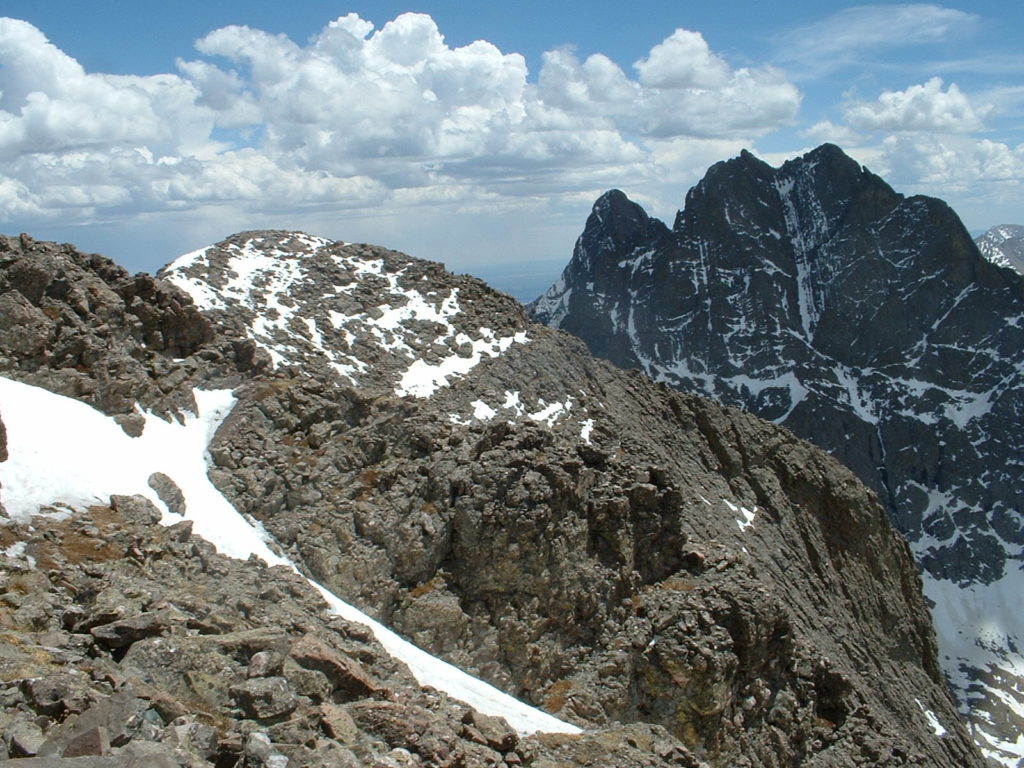 Kit Carson Peak (14,165′) / Columbia Point (13,980′) / Challenger Point (14,080′)
Kit Carson Peak (14,165′) / Columbia Point (13,980′) / Challenger Point (14,080′)Distance (Round-trip): abt. 11.6 miles
Elevation Gain: 6,150+ feet
Class 4, with some ice and snow
May 20, 2006
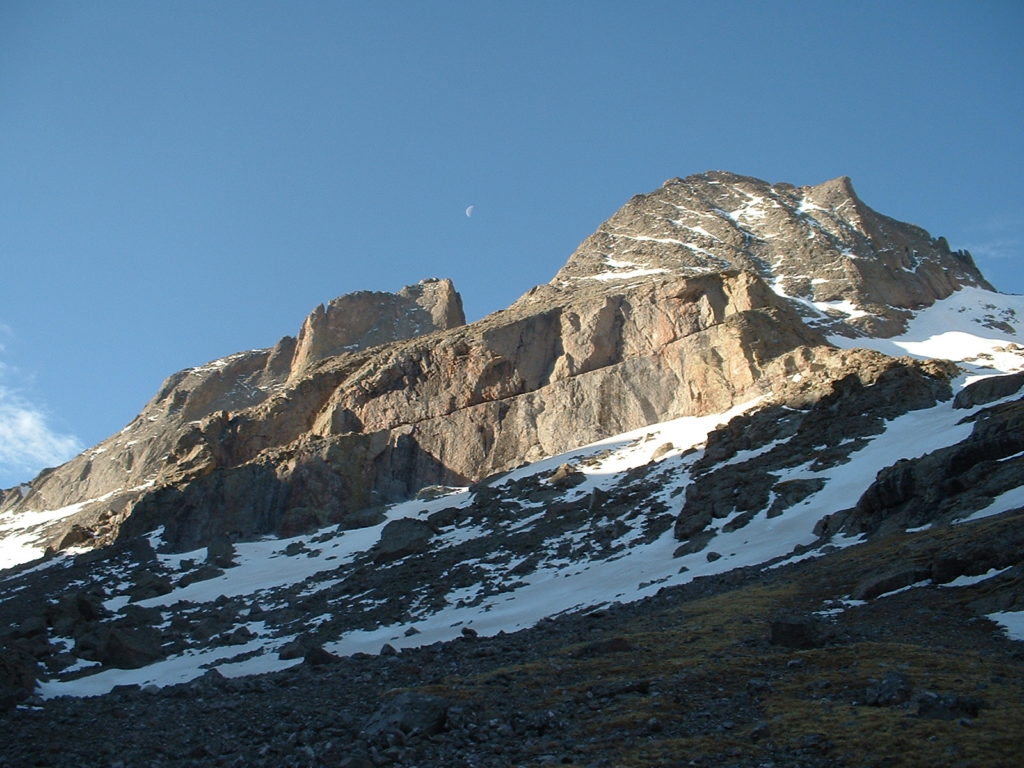 The Kit Carson Massif is not a typical gigantic Colorado mound of talus, nor is it cluttered by roads or mining claims. It is pristine but gargantuan, and not easy to access. Three main summits rise from this complex mountain. Kit Carson Peak, the highest of the three, is guarded by impressive cliffs to the north (4th class North Ridge) and south (The Prow- 5.8). Yet there is no direct access from the east or west either, because the mountain is flanked by Challenger Point and Columbia Point (formerly known as “Kat Carson”). Challenger and Columbia are both named for the shuttle disasters that occurred in 1986 and 2003. Plaques were placed on these summits in memory of those who died in those tragedies. Acquiring the summits of these peaks is no easy task, either, and climbing all three in one day makes a memorable Tour de Kit Carson. I had been studying the routes and reading trip reports for these mountains, and at last a one day window of opportunity coincided with perfect climbing conditions and a decent weather forecast. So, after a four hour drive from Denver and a four hour nap in my jeep at the South Crestone Trailhead, I was on my way.
The Kit Carson Massif is not a typical gigantic Colorado mound of talus, nor is it cluttered by roads or mining claims. It is pristine but gargantuan, and not easy to access. Three main summits rise from this complex mountain. Kit Carson Peak, the highest of the three, is guarded by impressive cliffs to the north (4th class North Ridge) and south (The Prow- 5.8). Yet there is no direct access from the east or west either, because the mountain is flanked by Challenger Point and Columbia Point (formerly known as “Kat Carson”). Challenger and Columbia are both named for the shuttle disasters that occurred in 1986 and 2003. Plaques were placed on these summits in memory of those who died in those tragedies. Acquiring the summits of these peaks is no easy task, either, and climbing all three in one day makes a memorable Tour de Kit Carson. I had been studying the routes and reading trip reports for these mountains, and at last a one day window of opportunity coincided with perfect climbing conditions and a decent weather forecast. So, after a four hour drive from Denver and a four hour nap in my jeep at the South Crestone Trailhead, I was on my way.Kit Carson: North Ridge Success!
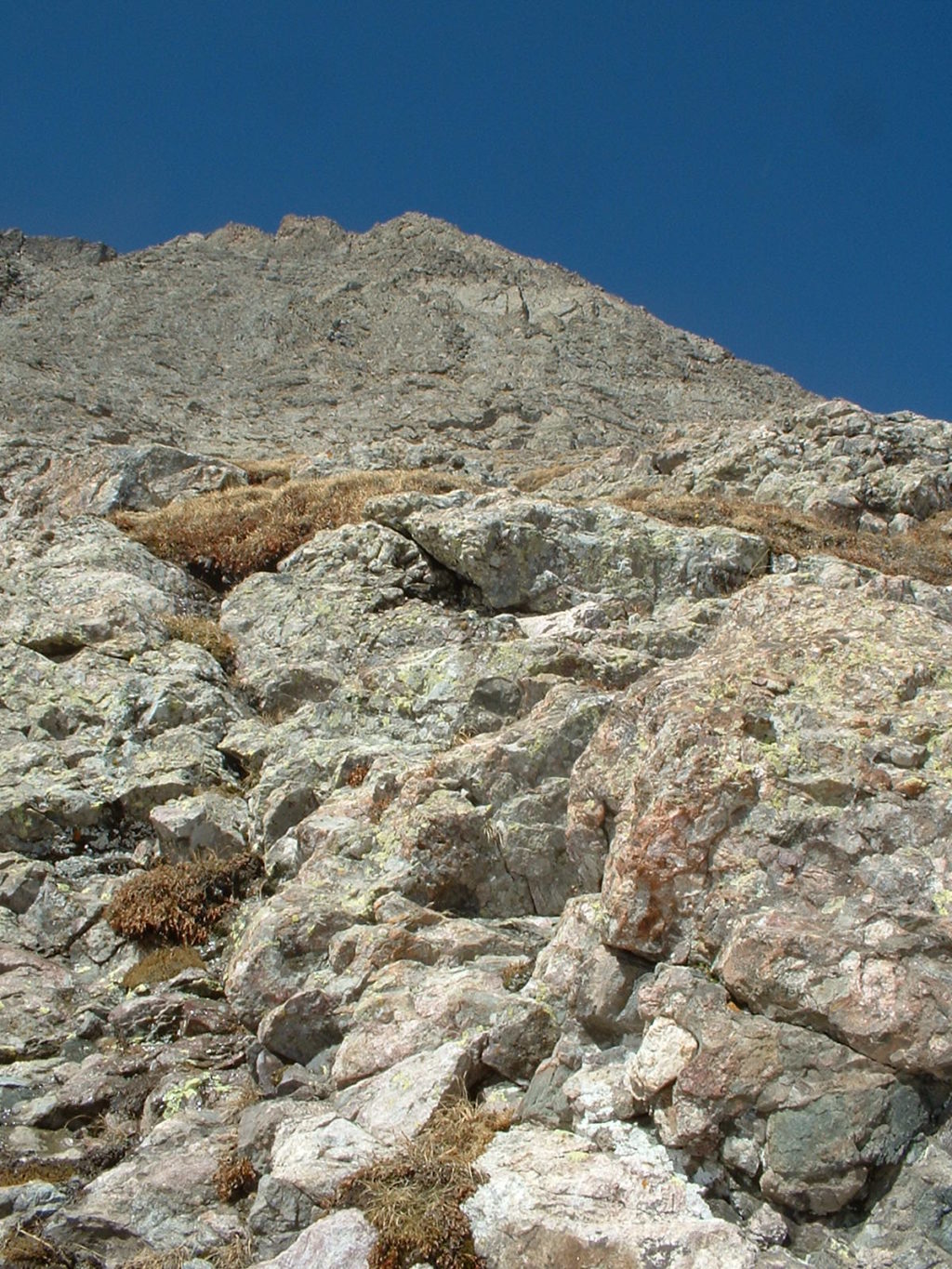 I started early up the Willow Creek Trail. It was 3:30 in the morning, and already the air was warm, even at 9,000 feet. I stripped down to my t-shirt, but still I sweated profusely as I marched up the switchbacks leading up an endless hill in the dark oblivion. Two and a half hours later I emerged from the forest in front of the enticing Willow Lake. The sun was just beginning to light everything, including the reflections of the surrounding mountains on the calm water. Behind the lake were vertical cliffs punctuated at intervals by frozen waterfalls. Above the cliffs, the forest disappeared, replaced by alpine tundra and willows. And above it all towered Kit Carson Mountain and its intimidating summits. Appropriately, the moon hung directly over the summit of Columbia Point. What a scene!
I started early up the Willow Creek Trail. It was 3:30 in the morning, and already the air was warm, even at 9,000 feet. I stripped down to my t-shirt, but still I sweated profusely as I marched up the switchbacks leading up an endless hill in the dark oblivion. Two and a half hours later I emerged from the forest in front of the enticing Willow Lake. The sun was just beginning to light everything, including the reflections of the surrounding mountains on the calm water. Behind the lake were vertical cliffs punctuated at intervals by frozen waterfalls. Above the cliffs, the forest disappeared, replaced by alpine tundra and willows. And above it all towered Kit Carson Mountain and its intimidating summits. Appropriately, the moon hung directly over the summit of Columbia Point. What a scene!
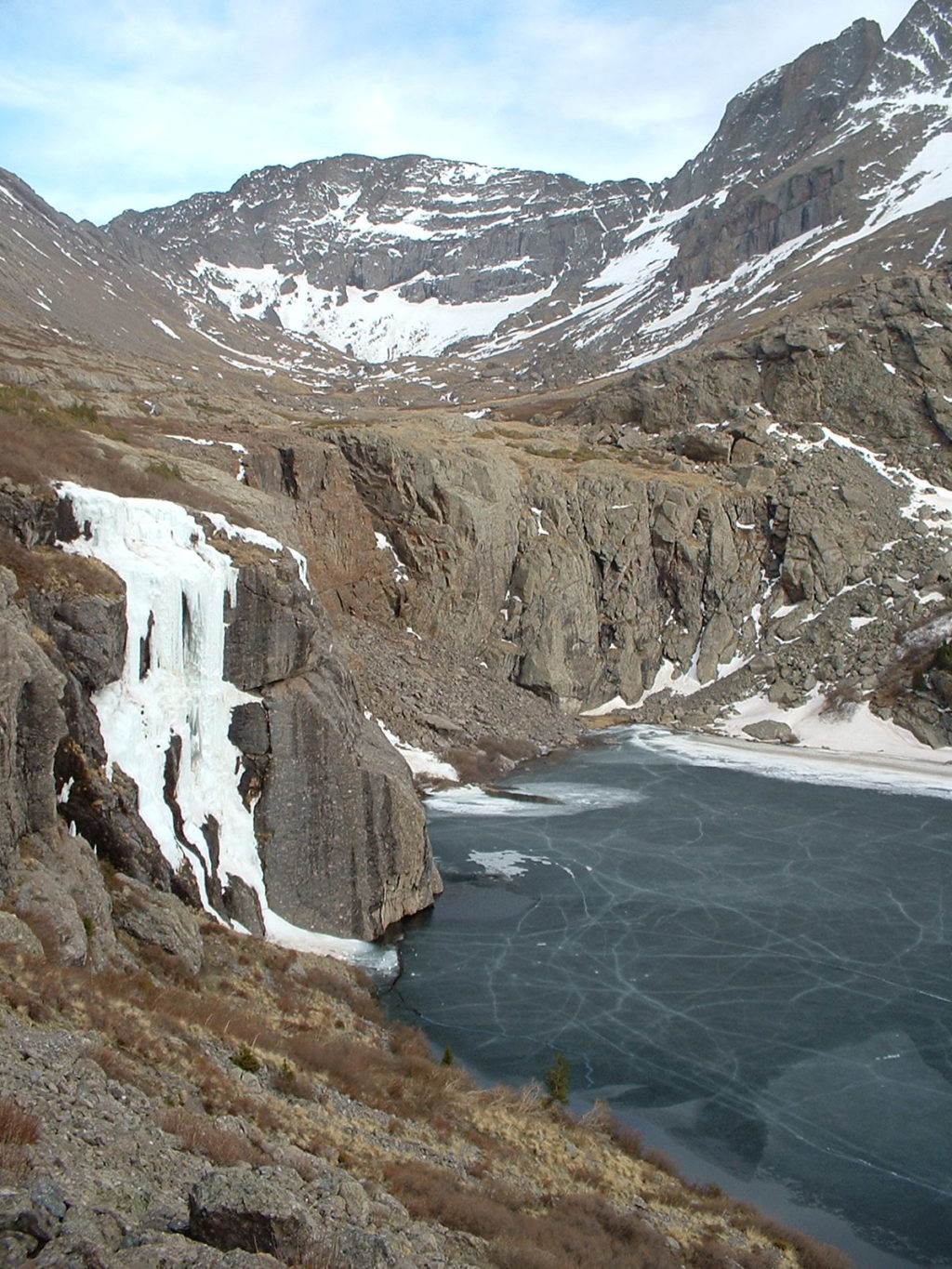
Because of a surprising lack of snow, I made excellent time through the basin, arriving as promised at a boulder field below sheer cliffs of Kit Carson’s north face. Here I encountered the first real amount of snow, but it was all solid and I quickly made my way upward to the slopes of dry talus. As it became apparent I would soon begin climbing in earnest, I stopped to make a number of adjustments, including a snack, sun screen, a change of boots, and the addition of a climbing helmet. All would come in handy.
At 7:45, after over four hours of hiking, my climb began, but it would not get off to as productive a start as I had hoped. As I entered the sun-bathed slopes of scree and talus, I tried to pick out my route on the grassy ledges above me. I quickly found myself in some 4th class territory, but the terrain around and above me became increasingly technical, and several times I had to backtrack to find an easier way. Finally, I came to a place where I could not go any further without some 5th class moves, and I began to question my route-finding.
After much internal debate and rereading of route descriptions and trip reports, I determined I had not gone far enough into the basin before beginning my ascent. Indeed, I had started upward before completely passing the band of cliffs above the boulders. This turned out to be a huge mistake, costing me not only time and energy, but favorable snow conditions as well. For, as I descended and rounded the rest of the cliffs, I came onto numerous snow fields which were already becoming annoyingly soft under the rays of the sun. After some ridiculous post-holing, I began to resort instead to climbing along 4th class rock ledges, this time leading to the correct grassy ledges above. After crossing one final (and more solid) snow field, I was at last on the second and third class ledges I had been trying to find all along.
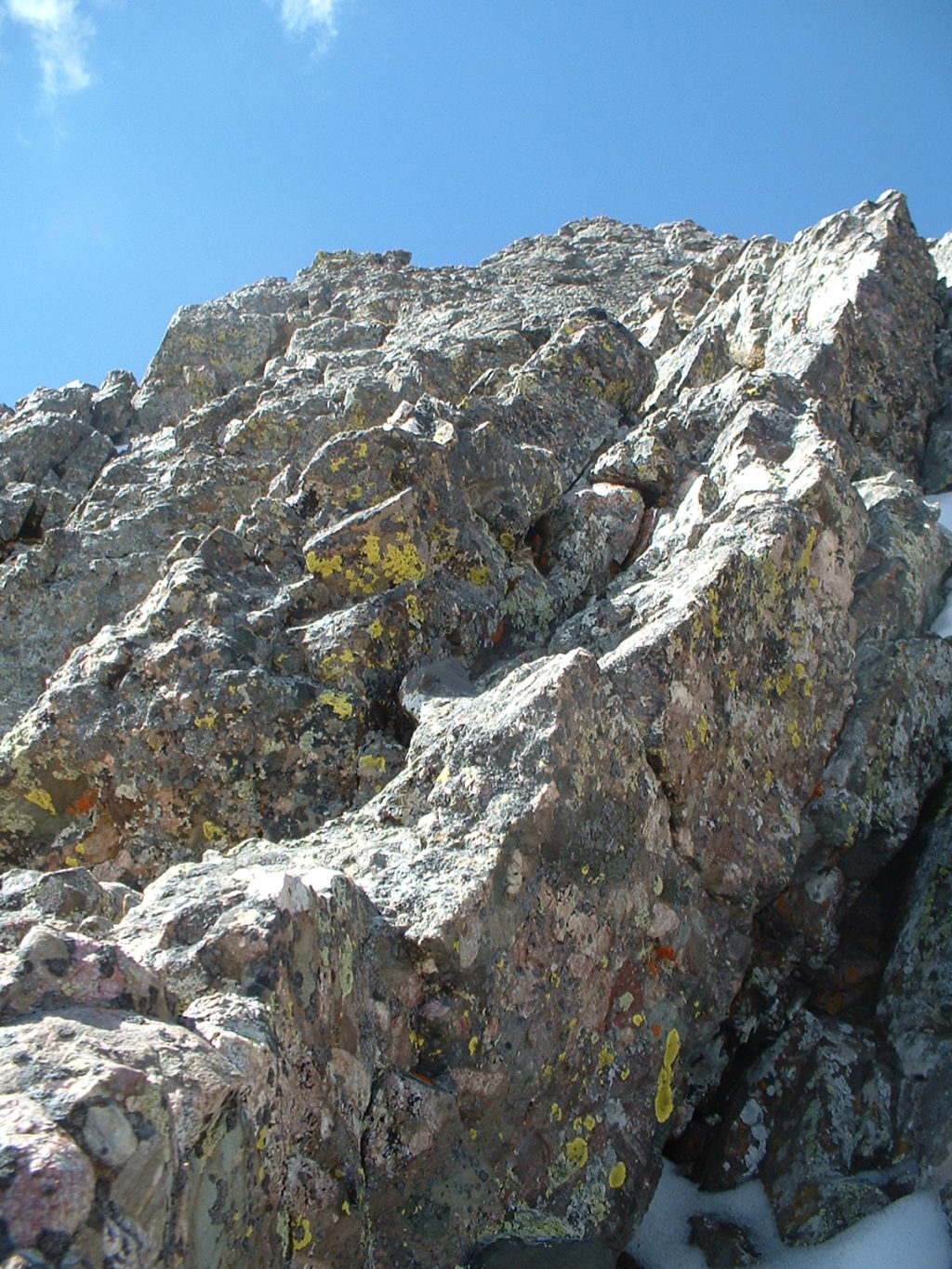
Though I could see the shaded Outward Bound Couloir filled with snow above me, I had very little snow to deal with the rest of the way up this steep, sun-hammered face. A welcome relief, I swiftly moved up the grassy ledges until I was once again negotiating 4th class terrain. This section of my climb ended up being one of the most exposed climbs of the day, mainly because I did not find the ridge-proper soon enough. I was concentrating so much on maintaining three points of contact and gripping solid holds, that I had quickly gained several hundred feet, but to the left of the ridge proper. This was an incredibly steep area I wanted to get away from to avoid more technical terrain. So, I angled sharply to the right when the holds allowed, and in a short time found myself relieved to be standing on the jutting North Ridge. Route-finding would not be a concern the rest of the way to Kit Carson’s summit.
It had been a pain to even find the North Ridge, but now that I was finally on its spine, the conglomerate knob climbing was exciting, the relentless exposure invigorating. At two or three places along the ridge, notches were filled with a gully of snow, but these did not hinder my progress too much. Ninety percent of the ridge was completely dry, and I needed only to focus on the security of my hand and footholds. The 3rd and 4th class climbing on this ridge was a truly memorable mountaineering experience!
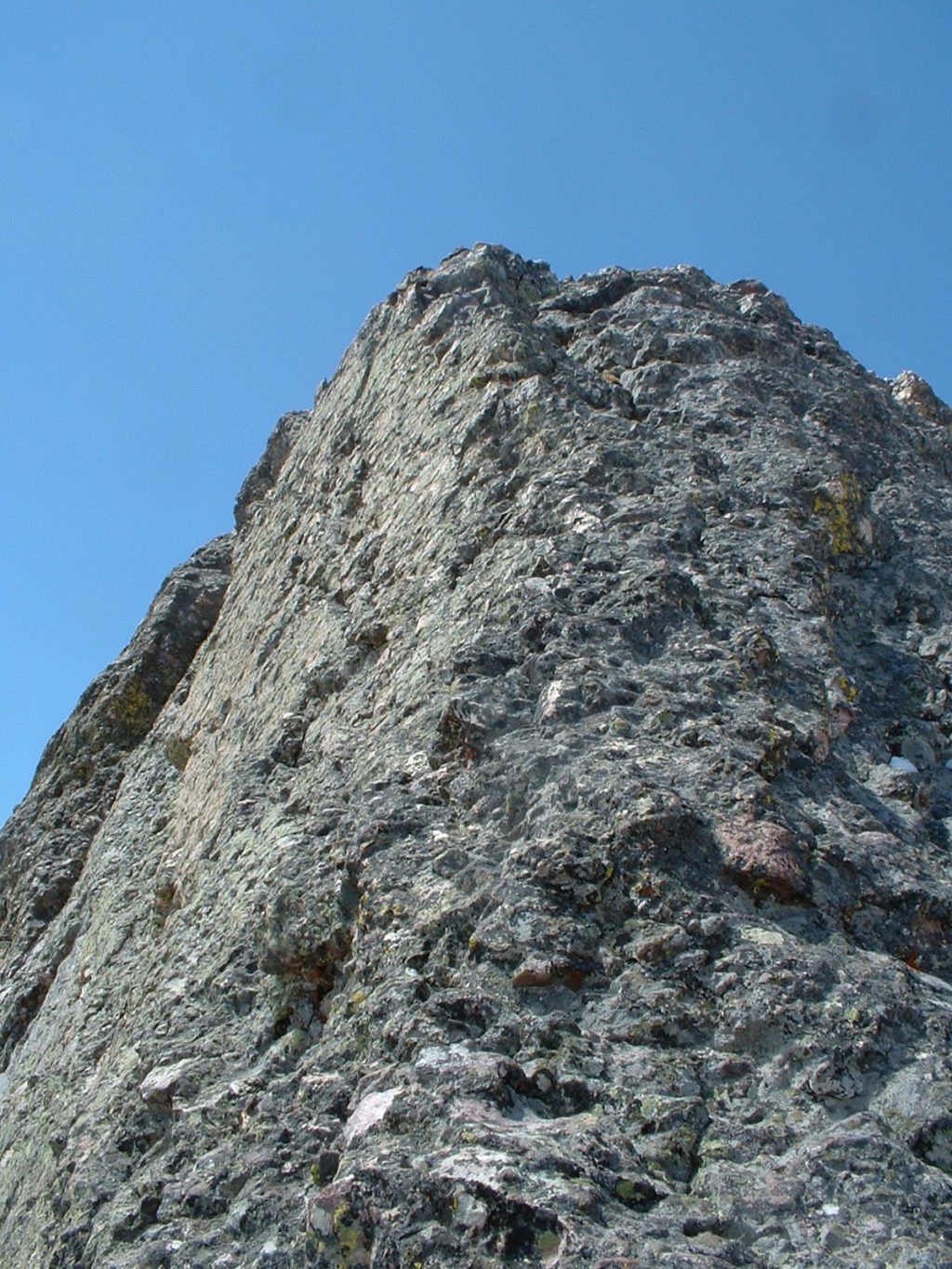
Near the top, the ridge suddenly flattened out to the summit of Kit Carson Peak. I scrambled over to the highest point at 14,165 feet, and admired the stunning view. I had made it to the summit at 11:45, but I still had some of the toughest climbing ahead of me. The weather appeared to be okay, but it would deteriorate quickly soon after leaving the summit.
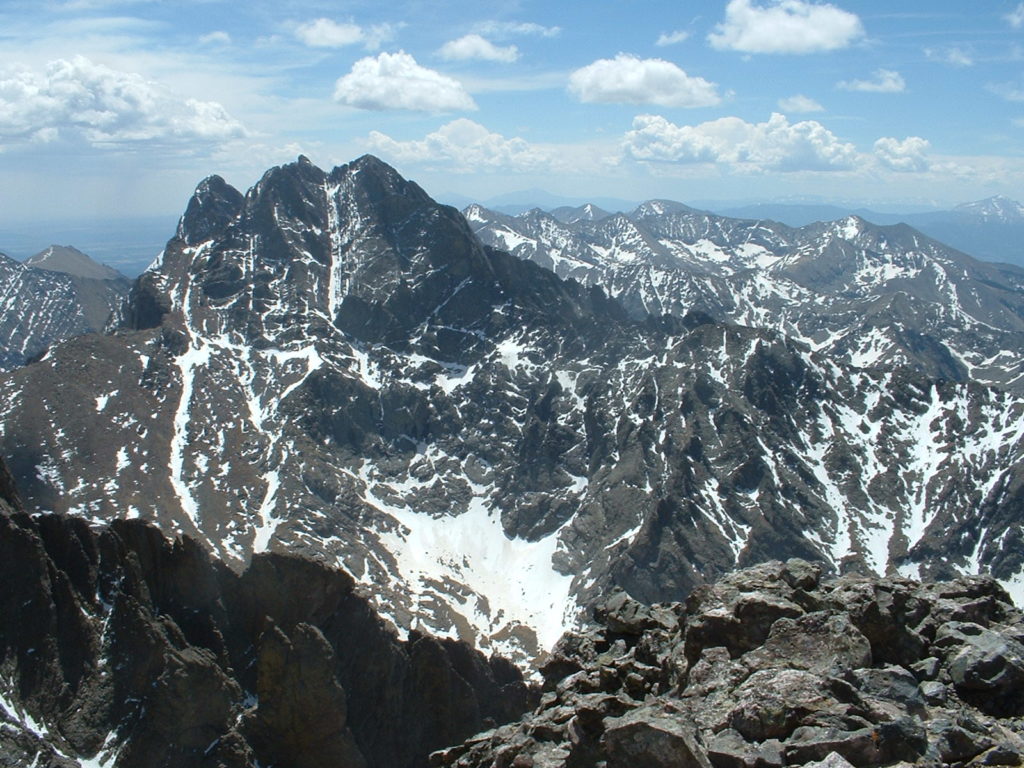
During my climb and summit stay of Kit Carson, I had been previewing the route to Columbia Point. I had never been able to find any definitive information for this short 3rd class mess of rock–even guidebooks are vague–but I had heard varied reports of difficult route-finding and exposed moves.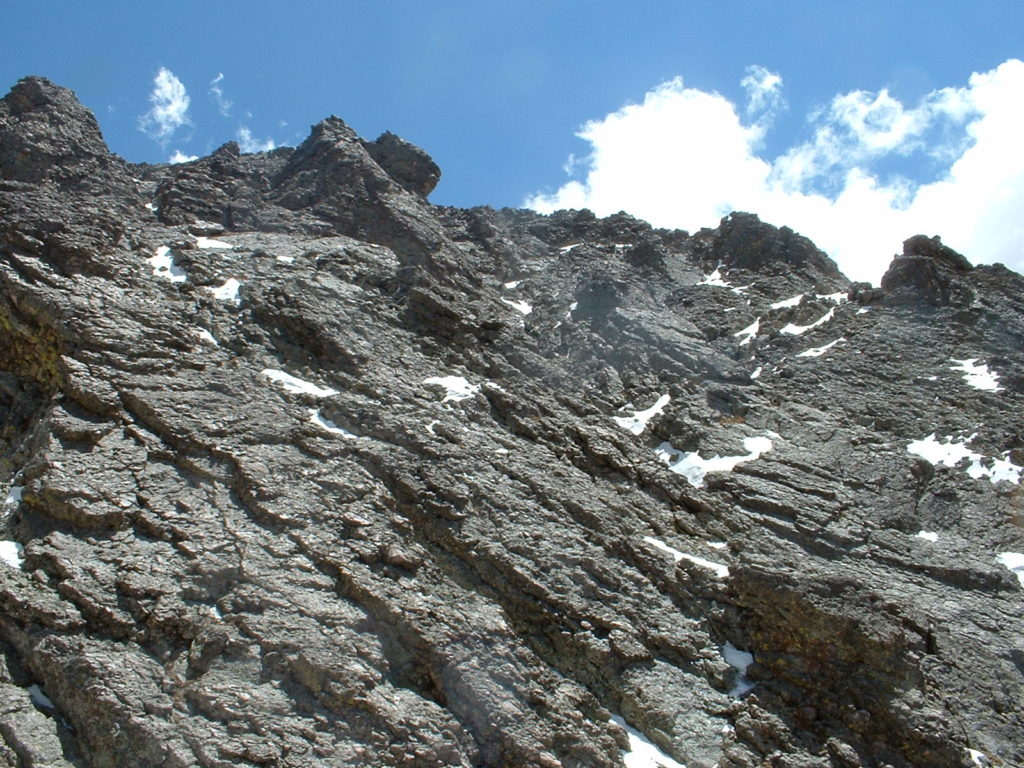 Now I know why. This gnarly traverse is anything but straight-forward, and though short in distance, it is not something to be taken lightly. Today, I had the added challenge of snow and ice filling many of the cracks and gullies I would be forced to cross. Meanwhile, the skies to the west grew darker, and I began to feel an added sense of urgency as I approached the Kit Carson-Columbia saddle.
Now I know why. This gnarly traverse is anything but straight-forward, and though short in distance, it is not something to be taken lightly. Today, I had the added challenge of snow and ice filling many of the cracks and gullies I would be forced to cross. Meanwhile, the skies to the west grew darker, and I began to feel an added sense of urgency as I approached the Kit Carson-Columbia saddle.
After following cairns over a jutting ridge, I crossed a snow-filled gully, and made a difficult 4th class move to gain the opposite slopes. From here, I found myself in a consistent 3rd and 4th class maze of rock and ice, but I will describe my route as best as I can recall.
First of all, I stayed to the right of a snow chute, climbing an exposed wall until I cliffed out. Here, I found myself looking into an abyss which was the top of the Outward Bound Couloir. At first I was disheartened with the view, but then I found a way to down-climb to some flatter terrain. Here, cairns led me around the terminus of the Outward Bound Couloir, to the base of the southwest face of Columbia Point. Immediately, I was faced with more route-finding difficulties. The climbing was not too difficult; what I was concerned about was being able to down-climb the same terrain.
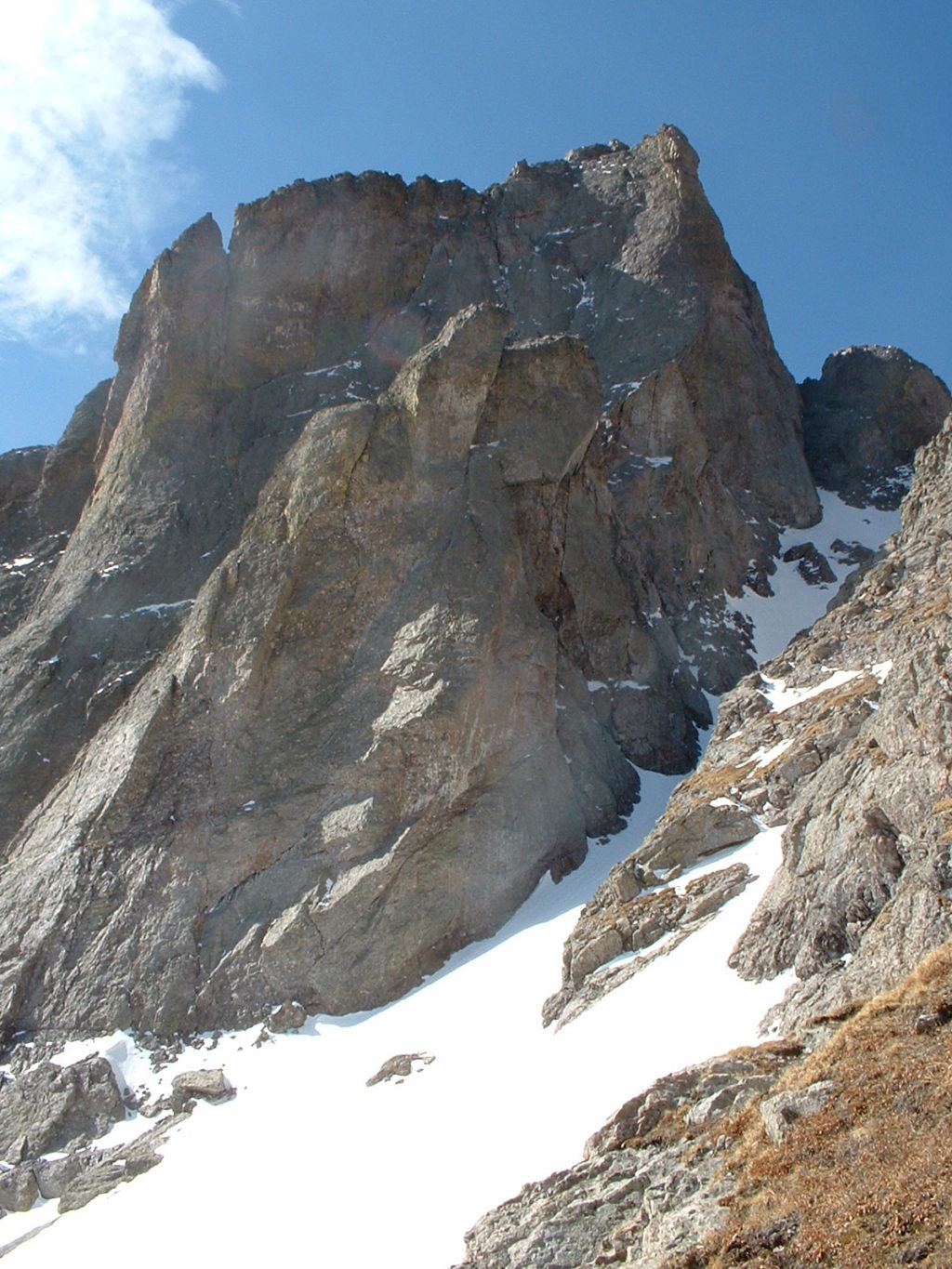
I signed the summit register (first since February 9th) and grabbed a quick bite to eat, but all my thoughts at the time were focused on the weather. Not only were the storm clouds with visible rain getting closer, I could now clearly hear the booming of thunder. The potential for wet rock was bad enough; I did not want my ice axe to be acting as a lightning rod as well. I had already formulated bail plans, the least technical of which would place me in the Spanish Creek Drainage, an entirely different valley, miles from where I wanted to be. The only other option was to quickly down-climb back to the saddle and make a speedy descent of the Outward Bound Couloir. It was beginning to look like Challenger would have to wait for another day.
Using my ice axe, I stuck more to the upper couloir on my initial descent. Then I followed the ledges down to the flatter terrain near the saddle. Looking up again, I was amazed: the storm had passed without even touching the area! It had been so close while I was on Columbia Point’s summit, and it was moving my direction, but now the black skies and lightning had literally disappeared! Thanking God for this break, I passed the head of the Outward Bound Couloir and continued back toward Kit Carson.
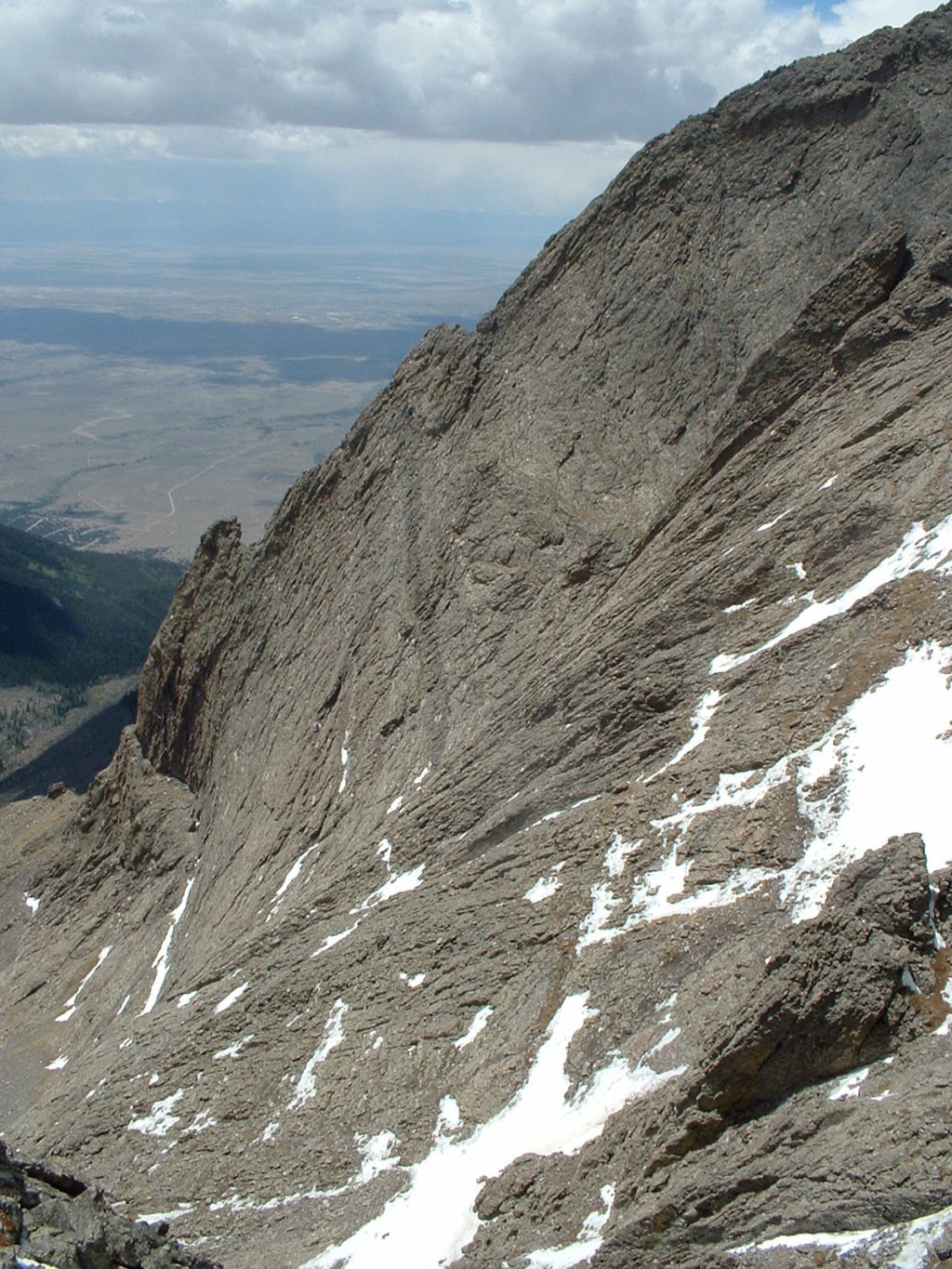
Icy Avenue to Challenger Point
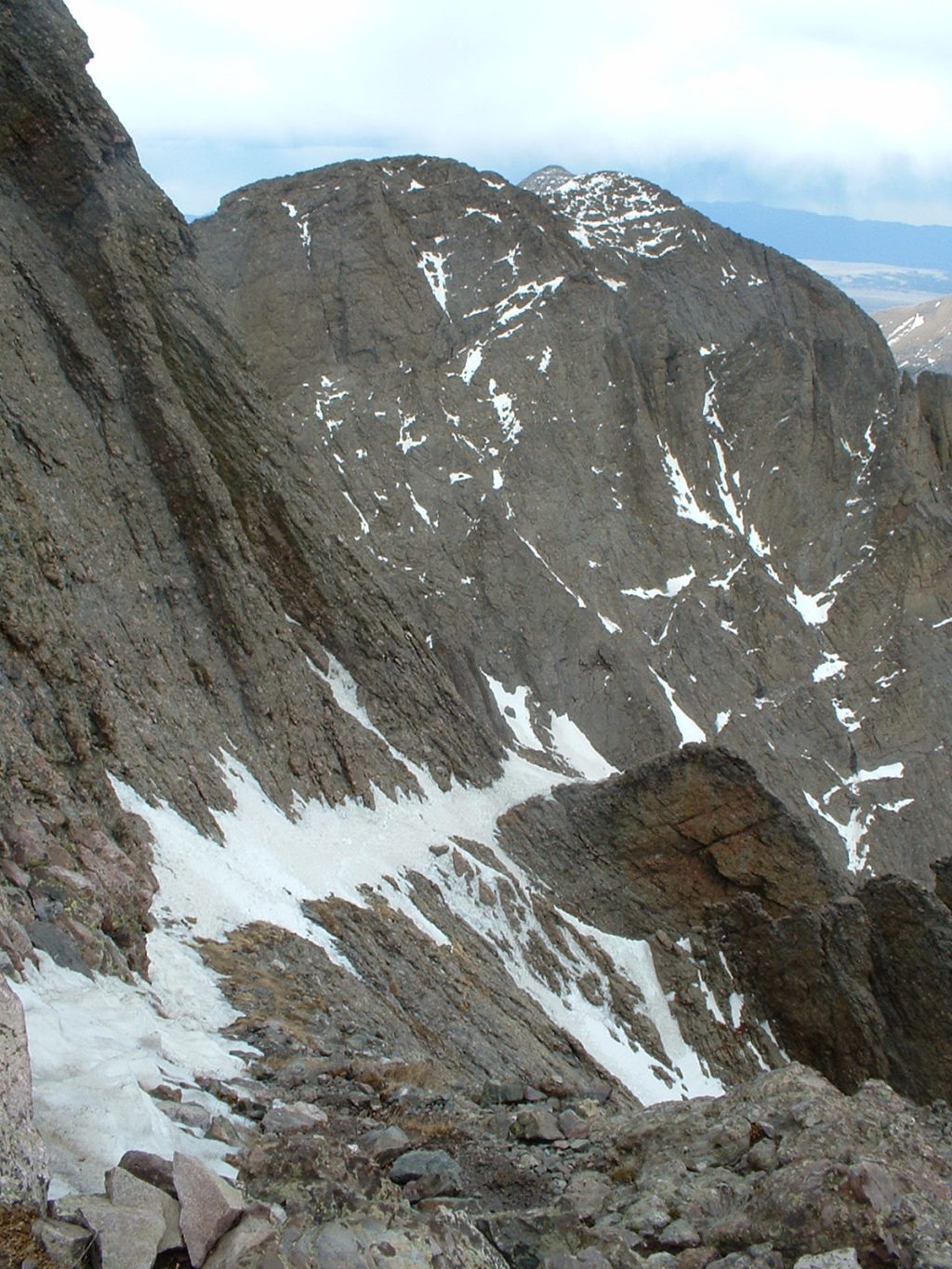
As I approached the Avenue, I stopped to don my crampons for the first time this year. Then, after eating some more energy food, I marched upward to the beginning of the traverse.
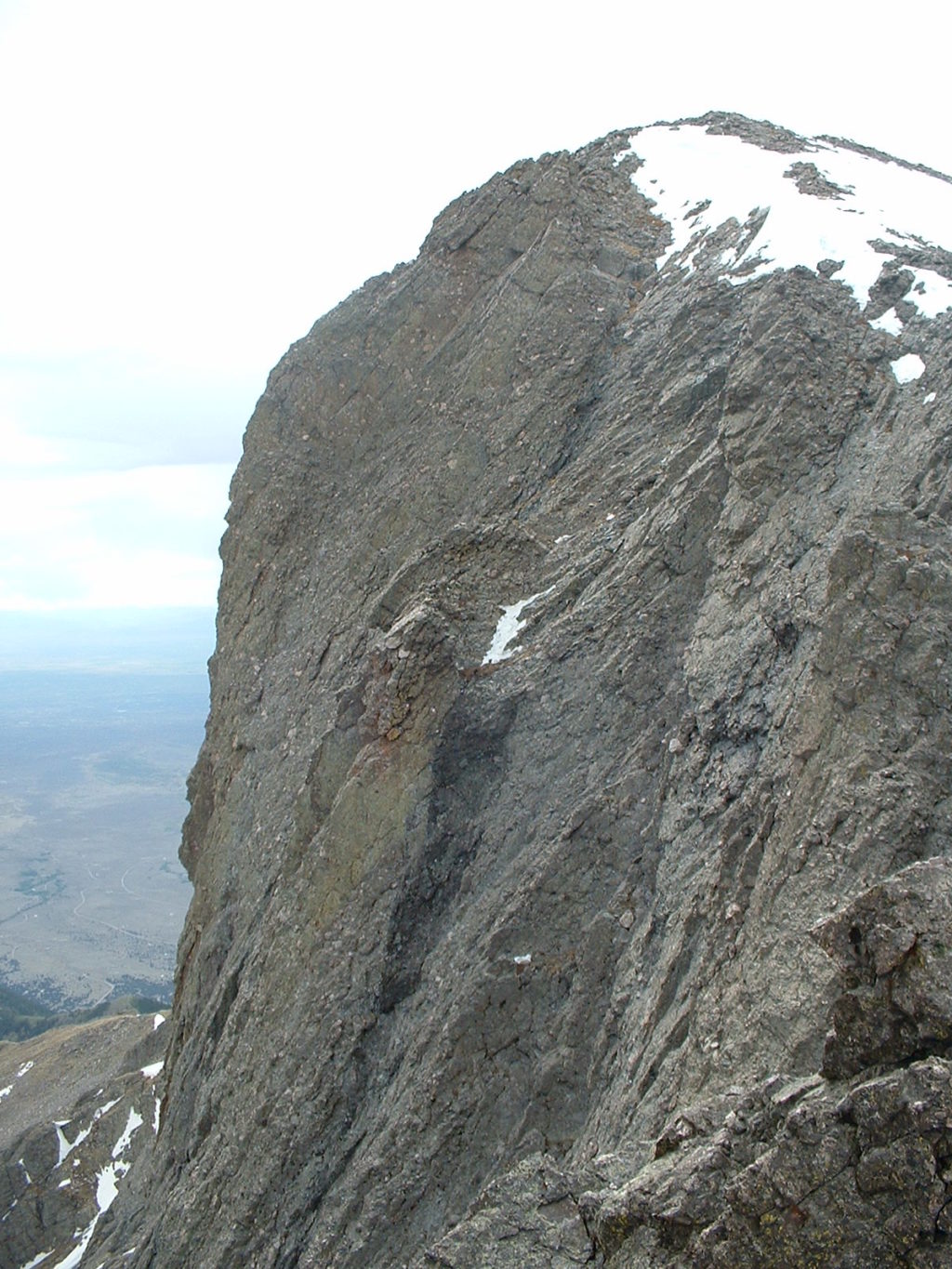
The south-facing side of the Avenue was more slushy than icy, but crampons and ice axe were a necessity as the snow formed a steep slope in the small section where there is a flat ledge in summer. Rounding the corner, I found the west-facing half of the Avenue to be almost identical in configuration, but it was sloping downhill, and was of more of an icy consistency. Because of this, I took it slowly and made sure my crampons gripped every step before I lifted my other foot. At the end of the traverse, I stepped onto the small saddle separating Kit Carson Peak from Challenger Point.
Leaving my crampons on, I tromped up an easy snow slope to the summit of Challenger Point. The summit register and plaque commemorating the crew of Challenger were buried under the winter’s snowpack, so I just sat, relaxed, and enjoyed the well-earned view. I still felt fine, though I knew I had a long way back to Denver. Unfortunately, my route-finding issues still were not done for the day.
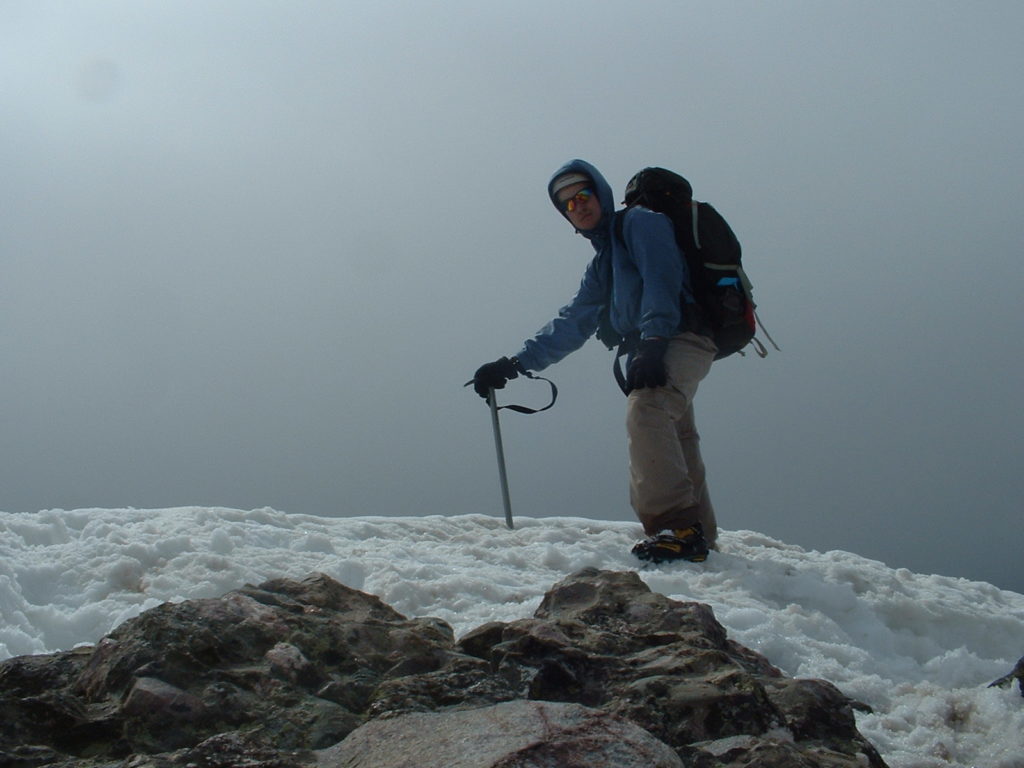
I encountered no one at the lake this time, but before long I passed a backpacker who inquired about Kit Carson’s North Ridge. I assured him it is “in” and wished him luck, then I continued out the trail.
Fifteen minutes later, it was de ja vu all over again. I nearly had a heart attack as not two, but three dogs came out of nowhere, barking like crazy. They seemed a little braver with three in the pack. In the trees off to the side of the trail, I saw the same lady as before. She had changed locations, but her guard dogs still felt the need to protect “their” trail from intruders. We went through the same process: she called and called until they finally moseyed back to her, and I never heard another peep. Tired and annoyed, I moved on, enjoying a peaceful stroll the rest of the way out through the valley. Near the trail register at twilight, I encountered a herd of about a dozen deer, moving into an open field for their evening meal. At 8:30, I arrived back at my jeep, questioned my sanity for the umpteenth time, and drove the four and a half hours back to Denver.
